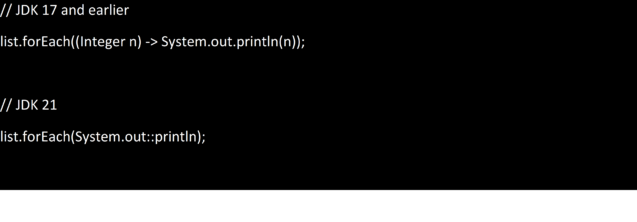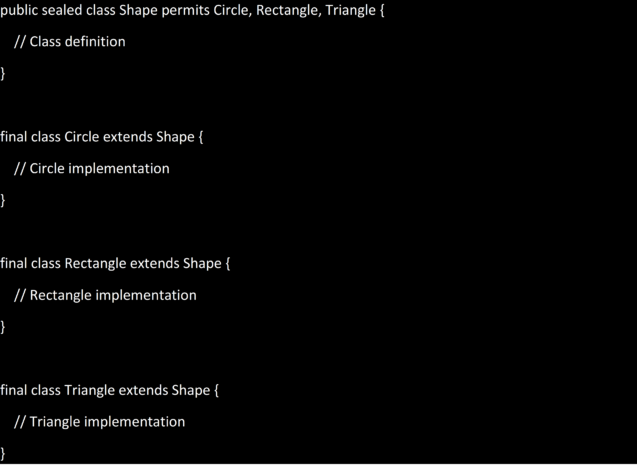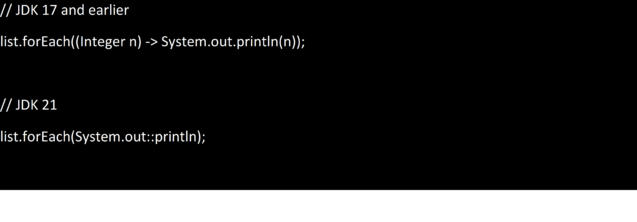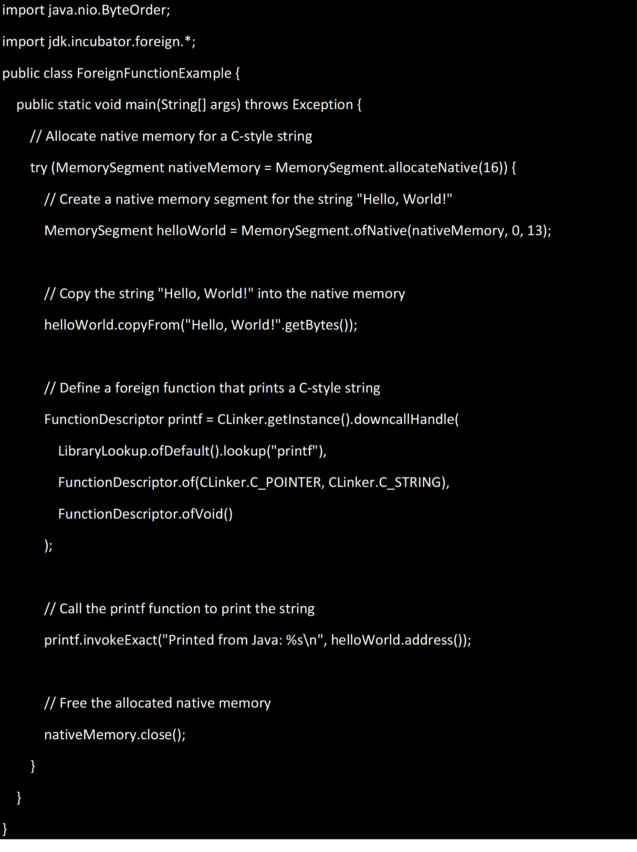Java Development Kit (JDK) 21 is the latest major release of the Java platform, following the previous LTS version, JDK 17. It continues to build upon the solid foundation that Java has established over the years, while also introducing several enhancements aimed at making the language more efficient, productive, and developer-friendly.
Introduction to JDK 21
Java, one of the most popular programming languages in the world, has come a long way since its inception. With each new release, the Java platform continues to evolve, bringing exciting features and improvements to developers. In this article, we’ll explore the latest release, JDK 21, and delve into its new features and enhancements.
One of the key goals of JDK 21 is to keep Java relevant in the ever-evolving landscape of software development for Java developers. With new features, performance improvements, and enhanced libraries, Java remains a versatile and dependable choice for a wide range of application development needs.
New Features in JDK 21
Let’s dive into the new features that JDK 21 brings to the table.
-
Pattern Matching for Switch
Pattern matching for switch expressions is one of the most anticipated features in JDK 21. It simplifies code by allowing developers to perform both type checking and type casting in a single step. This is especially useful when dealing with complex data structures. Here’s a simple example of how pattern matching for switch can be used:
This feature simplifies the code and makes it more readable by eliminating the need for explicit casting and reducing boilerplate code.
2. Records Enhancements
Records were introduced in Java 16, providing a concise way to define classes that are primarily used to store data. In JDK 21, records have received some enhancements, making them even more powerful. Now, you can add methods to records, making them more versatile.
This allows you to combine the benefits of an immutable data class with the convenience of methods for common operations.
3. Sealed Classes
Sealed classes and interfaces provide developers with more control over class hierarchies. You can explicitly specify which classes can be subclasses or which interfaces can be implemented. This helps in maintaining code integrity and prevents unintended inheritance.
Sealed classes ensure that only the permitted classes (in this case, Circle, Rectangle, and Triangle) can extend Shape.
4. Concise Method References
JDK 21 introduces a more concise syntax for method references. It simplifies the code by allowing you to omit redundant type information when using method references.
This change reduces visual noise in the code and makes it more readable.
5. Improved Foreign Function & Memory API
JDK 21 enhances the Foreign Function and Memory API, which was introduced as an incubator feature in JDK 16. This API allows Java programs to interact with native code and memory more efficiently.
Developers can use the improved API to work with foreign function declarations and memory layouts, enabling better integration with non-Java libraries and systems.
Here’s a simple code example that demonstrates how to use the improved Foreign Function and Memory API in JDK 21 to interact with native code and memory. In this example, we’ll use the MemorySegment class to allocate and manipulate native memory and FunctionDescriptor to declare and call a foreign function.
In this code:
We allocate native memory using MemorySegment.allocateNative(16). This memory can be used to store C-style strings or other native data.
We create a MemorySegment named helloWorld within the allocated memory to hold the string “Hello, World!”.
We use MemorySegment.copyFrom to copy the string “Hello, World!” into the native memory.
We define a foreign function printf using CLinker to match the C printf function’s signature, specifying that it takes a C-style string (C_POINTER) as its argument.
We call the printf function using invokeExact, passing the format string and the address of the helloWorld segment as arguments. This demonstrates how you can call C functions from Java.
Finally, we close the allocated native memory segment to release the allocated resources.
Please note that this code is a simplified example for demonstration purposes. In practice, when working with native code and libraries, you should handle error checking, resource management, and other considerations to ensure robustness and stability in your application.
6. Unix-Domain Socket Channel
Java 21 introduces a Unix-Domain Socket Channel, allowing Java applications to communicate over Unix domain sockets. This feature is particularly useful for inter-process communication on Unix-based systems.
This addition expands Java’s capabilities for low-level network programming on Unix platforms.
7. Enhanced Libraries
JDK 21 also includes enhancements to existing libraries. Notable improvements include:
- Stream API enhancements: The Stream API now supports efficient, primitive specializations for streams of int, long, and double values, reducing boxing/unboxing overhead.
- Improved Collections: Java’s collection libraries have received performance improvements and new methods, making it easier to work with collections in a more idiomatic way.
Challenges of the new JDK 21
While the new features in Java 21 bring many benefits to the language, they can also introduce certain difficulties and challenges for developers. It’s essential to be aware of these challenges to use the new features effectively. Here are some potential difficulties and challenges with the new features in Java 21:
- Compatibility Issues: When adopting a new Java version, existing codebases may face compatibility issues. Code that relies on deprecated features or relies on behaviors that have changed in the new version may require modifications. This can be a significant challenge for large projects.
- Learning Curve: Learning and understanding the new features and enhancements introduced in Java 21 can be a challenge for developers, especially those who are not familiar with advanced language features like pattern matching, sealed classes, or foreign function interfaces.
- Migration Effort: Migrating existing projects to use Java 21 features can be time-consuming and require careful planning. Developers need to assess the impact on their codebase and make necessary adjustments.
- Integration with Legacy Code: Integrating the new features into existing code, especially legacy code, can be challenging. It may require refactoring or adapting existing code to take advantage of the new language features.
- Ecosystem Compatibility: Some third-party libraries and frameworks may not yet fully support Java 21. Developers may need to wait for updates from these libraries or find workarounds to make them compatible.
- Pattern Matching Complexity: While pattern matching simplifies code in many cases, it can become complex when dealing with deeply nested or intricate data structures. Developers need to carefully design patterns to ensure readability and maintainability.
- Sealed Classes Management: Sealed classes provide better control over class hierarchies, but they require careful planning. Deciding which classes can extend a sealed class and maintaining that hierarchy can be challenging as the project evolves.
- Migration Strategy: When adopting new features, especially in a team, deciding on a migration strategy and ensuring consistent usage of these features across the codebase can be challenging. This includes setting coding standards, conducting code reviews, and providing training to the team.
- Tooling and IDE Support: While major Integrated Development Environments (IDEs) like IntelliJ IDEA and Eclipse typically provide support for new Java features, there might be limitations or bugs in early releases. Developers may need to keep their IDEs up to date and be prepared to work around any issues that arise.
- Testing and Debugging: New features can introduce new opportunities for bugs or unexpected behavior. Thorough testing and debugging are essential to ensure that the code functions as expected, especially when using advanced language features.
- Documentation and Resources: Finding comprehensive documentation and learning resources for the latest Java features can be a challenge, especially shortly after a new release. Developers may need to rely on official documentation, community forums, and tutorials to fill the knowledge gap.
- Backward Compatibility: While Java aims to maintain backward compatibility, there can be instances where existing code or libraries are affected by changes in new Java versions. Developers need to be cautious when updating their projects.
Despite these challenges, it’s important to note that adopting the new features in Java 21 can ultimately lead to improved code quality, maintainability, and performance. To mitigate these challenges, developers should stay informed about updates, plan migrations carefully, and be prepared to invest time in learning and adapting to the new features. Over time, the benefits of using the latest Java features can outweigh the initial difficulties.
Conclusion
JDK 21 brings exciting new features and enhancements to the Java platform, making it more powerful and developer-friendly than ever before. Whether you’re an experienced Java developer or just starting your journey in programming, these improvements will help you write cleaner, more efficient code. If you need professional help in developing Java solutions or updating existing app, Elinext team is ready to support you on every development stage. Contact us here.














